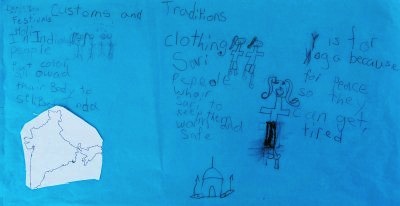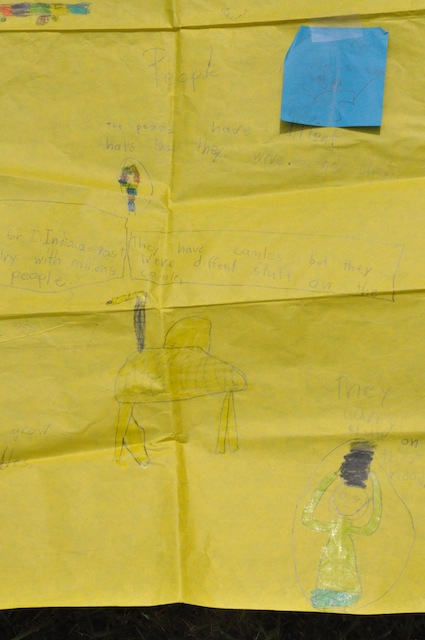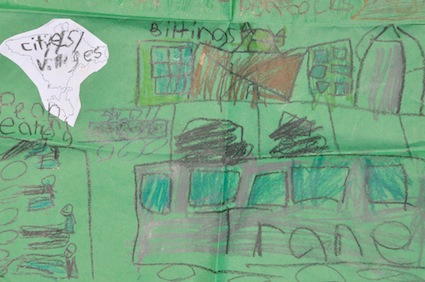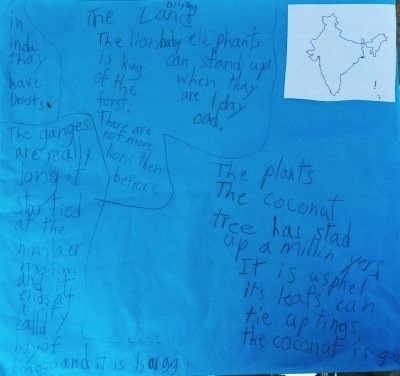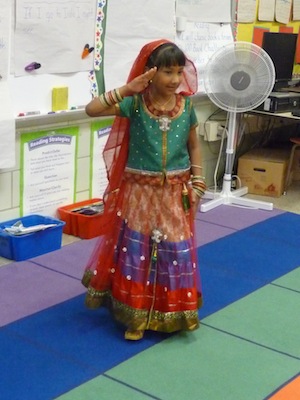Crossing Cultural Borders: Our Study of Indian Culture
Margaret Clarke-Williams
Through our focus in the first part of the school year on self identity, as Laura described in “Getting to Know Ourselves Through Global Literature,” our students developed understandings of themselves as cultural beings, including their outer visible characteristics as well as inner feelings and values. Cultural identity, though, also involves a global perspective and seeing ourselves as part of the world community (Banks, 2011). Cai (2002) states that when we “cross cultural borders [we] broaden our vision and shape ourselves to fit into a pluralistic world” (p. 118) and develop intercultural understandings. My first grade teammates and I decided to cross cultural borders through a study of India. We chose India because in the fall we’d read Same, Same But Different (Kostecki-Shaw, 2011), the story of two pen pals, one in the United States and the other in India, who write to each other, sharing information about where they live. While we and the children enjoyed the story, we were concerned about possible stereotypes that emerged, especially since I had three students with ties to India. We thought an in-depth study of India, as an example of another culture, would help the children appreciate not only the complexity of Indian culture but also of American culture. I also thought that my Indian students’ families would be good resources. We believed that a study of India would help us move from self identity and knowing our personal cultures to understanding and appreciating other cultural perspectives (Short & Thomas, 2011).
For an overview of our literacy community and school community, please see the first vignette in this issue, “Learning about Ourselves and Others through Global Literature.” In this vignette, I describe our study of India and how my students and I were immersed in learning about that culture. Michelle, in “Empowering Young Writers as Authors and Illustrators through a Study of India,” will share how the children pulled their learning about India together into nonfiction books that they wrote and illustrated.
Learning about India
We all started our studies by reading and discussing Elephant Dance: A Journey to India (Heine, 2004). We decided to begin with this book because it provides a rich general overview of Indian culture, foods, animals, and traditions through a series of questions young Ravi asks his grandfather about life in India.
|
Culture and Traditions
|
People and Families
|
|
Cities and Villages
|
Land, Resources, and Animals
|
Figure 1. Text Sets about India.
Before reading Elephant Dance, as a team we gathered resources, including numerous fiction and nonfiction books, about the country and culture of India. We grouped the books into four text sets: Culture and Traditions; People and Families; Land, Resources, and Animals; and, Cities and Villages. There was overlap among the sets but that allowed us to review some concepts we’d already discussed and keep them fresh. (See Figure 1 for a sampling of the books in each text set.) We decided to rotate the text sets so each of the four classes had a different set to study each week. 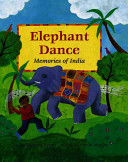 During the week, to help the children organize their learning, we gave each of them a large (3’ x 3’) piece of chart paper to be their graffiti paper for making notes and drawings about information they wanted to remember. To make the large sheets more manageable for the children (and us), we folded them into fourths so the children could use one section for each text set. The students had time each day to write notes on the topics of their choice that they found interesting. Examples of the graffiti notes are provided in the sections that follow. The children then used their graffiti notes to write their individual books about India. Below I describe how my class interacted with and responded to each text set.
During the week, to help the children organize their learning, we gave each of them a large (3’ x 3’) piece of chart paper to be their graffiti paper for making notes and drawings about information they wanted to remember. To make the large sheets more manageable for the children (and us), we folded them into fourths so the children could use one section for each text set. The students had time each day to write notes on the topics of their choice that they found interesting. Examples of the graffiti notes are provided in the sections that follow. The children then used their graffiti notes to write their individual books about India. Below I describe how my class interacted with and responded to each text set.
Culture and Traditions
My class started with the topic of Culture and Traditions. Among the books we read were India the Culture (Kalman, 2010), Prita Goes to India (Das, 2005), and India (Apte, 2009). As we read and discussed these books, Yash, Sarvesh, and Leah added to our learning by sharing their personal experiences with us. When we read about Diwali, the festival of lights, Leah brought in a couple of diyas (clay pots for the lights) and stories about Lakshmi (the goddess). She also described the puja (prayers) that are said. Yash brought in a picture of the Rangoli (art made from colored powder) that his family created to decorate his home. Sarvesh explained his participation in Holi, the festival of colors that takes place in the spring. He described the happy festivities where bright colored powder and liquids are thrown on the celebrants and onlookers. Daniela’s graffiti notes for this text set are below.
Figure 2. Daniela’s notes for the Culture and Traditions text set.
She included information about Holi, saris, and yoga.
People and Families
We went on to read about the People and Families. In India the People (Kalman, 2010), we learned about the various groups of people in India and the major role religion plays in their lives. The major groups are Hindu, Muslim, Sikh, Buddhist, and Christian. We discussed the visible attributes of these religions, such as their clothing, places of worship, and the sacred symbols of the various groups. For example, cows are sacred to the Hindus, and they are expected to bring good fortune for those who honor and protect them. During the festival of Pongal, cows are decorated and are part of the parades. Likewise, for the Sikhs, items of clothing hold special significance. Headdress is of particular importance. One of my students wanted to know more about the turbans that are worn by the Sikhs. I invited a second grade student, who was in my class last year, to come in to show his turban and to explain the importance of it to my class. We learned that Sikhs do not cut their hair, but wear it coiled on the top of their heads covered with a turban. This particular form of headdress is used to identify a person as a Sikh. Alex’s graffiti notes for the People and Families text set are below.
Figure 3. Alex’s notes for the People and Families Text Set
She noted that India has millions of people and the people ride camels, cover their heads, and carry things on their heads.
Cities and Villages
As we studied life in the cities and villages, we learned that family life is very important in the Indian culture but there are big differences between life in the cities and in the villages. The cities are denser with modern conveniences and the villages are sparse with very few, if any, modern conveniences.
We compared and contrasted how in India many generations of a family may live together as joint families while in America nuclear family units tend to live in single family dwellings. Several books, like Off to Class: Incredible and Unusual Schools around the World (Hughes, 2011) and Geeta’s Day (Das, 1999), gave us glimpses into schools in India. Some areas have school buildings and other times classes are held in places like train platforms. Sometimes teachers travel to villages so the children can attend school. Karl’s graffiti notes for the Cities and Villages are below.
Figure 4. Karl’s notes for the cities and villages text set
He noted that people eat on the ground, drew different types of buildings, and identified some different forms of transportation.
Land, Resources, and Animals
Our last text set was Land, Resources, and Animals. In this set we read books like I is for India (Das, 1996) and India the Land (Kalman, 2010). My students found it interesting that the ears of Indian elephants are in the shape of the country, with the Arabian Sea on the west and the Indian Ocean on the eastern side. They were also interested in learning about the Himalayan Mountains and the Ganges River that begins there and flows 1,557 miles to the Bay of Bengal. My students were curious about the sacred importance of water in the religious beliefs of the people. They asked many questions about the celebration of The Khumb Mela in the Ganges as well as the custom of scattering the ashes of cremated relatives there. Joshua’s graffiti notes for the Land, Resources and Animals text set are below.
Figure 5 Joshua’s notes for the land, resources and animals text set.
He included information on the Ganges River, lions and elephants, and coconut trees.
Learning from Families
Our interest in learning about India was peaking. Yash, Leah and Sarvesh wanted to have their parents involved. I contacted these parents, who were eager to come in to share their perspectives with all of the first grade students. Sarvesh’s parents gave a detailed presentation about the land, weather, people, languages, school system, foods, sports and the animals. His mother discussed the traditional clothing and described the sari (dress), dhoti (pants), dupatta (scarf) and sherwani (jacket). She explained the shalwar kameez (shirt and pants) that she was wearing as well as the kurta (shirt) that Sarvesh wore. There were many questions from the students about the Taj Mahal and the Qutub Minar, both special monuments in India. Students also learned about some of the inventions from India, like the digit zero, the game of Snakes and Ladders, and Chess. They also wanted to know more about the Neem tree whose branches are used as toothbrushes. There was a lot of interest in the bindi worn on her forehead and why families sit on the floor to eat their meals.
Yash’s father gave an in-depth look at the Indian baby naming ceremony – Namakaran. He explained that this is usually done on the 12th day after the baby’s birth. The name is given based on the time, date and position of the planets when the child is born. It is written with rice grains and whispered into the baby’s right ear four times. He explained that Yash’s birth name is Neal.
Leah performed a fusion of Folk and Classical Indian dance. She wore a brightly colored costume called a Lehenga Choli. She wore many bangles and had a bindi (jeweled decoration) on her forehead. She danced to a joyful Indian folk song and used a dandiya (colorful stick) to enhance her movements. Her mother explained that some types of dance are deeply religious and some are done on happy occasions. Here is a short video of Leah’s dance:
When we returned to our classroom, the students were eager to learn more from Leah, Sarvesh and Yash. Leah demonstrated the use of the mudra (hand gestures) that she used in her dance. These with facial expressions are used as a sign language to narrate the story. She then presented the girls in the class colorful bangles like hers and placed a jeweled bindi on each of their foreheads.
Figure 6. Leah’s dance.
The students were loaded with information about India when they started writing their books. They were engaged throughout this study, even in the last days of school. They were eager to read more books and they were attentive to their peers and parents. Through the study of India the children developed “conceptual understandings of culture [and] realized that their cultural perspectives were only one of many ways to view and live in the world” (Short & Thomas, 2011, p. 156). They not only learned about India but about themselves which enhanced their appreciation of other cultures as well as their own.
References
Apte, S. (2009). India. New York: Scholastic.
Bajaj, V. (2011). T is for Taj Mahal: An India alphabet. Illus. by R. Crawford. Ann Arbor, MI: Sleeping Bear Press.
Banks, J. (2011). Educating citizens in diverse societies. Intercultural Education, 22(4), 243-251.
Cai, M. (2002). Multicultural literature for children and young adults. Westport, CT: Greenwood.
Das, P. (1996). I is for India. London, England: Frances.
Das, P. (1999). Geeta’s day: From dawn to dusk in an Indian village. London: Frances Lincoln.
Das, P. (2005). Prita goes to India. London, England: Frances.
Heine, T. (2004). Elephant dance: A journey to India. Illus. by S. Moxley. Cambridge, MA: Barefoot Books.
Hermes, J. (1994). The children of India. Minneapolis, MN: First Avenue Editions.
Hughes, S. (2011). Off to class: Incredible and unusual schools around the world. Toronto, Ontario: Owlkids Books.
Kalman, B. (2010). India the culture. New York: Crabtree.
Kalman, B. (2010). India the land. New York: Crabtree.
Kalman, B. (2010). India the people. New York: Crabtree.
Kostecki-Shaw, J.S. (2011). Same, same but different. New York: Henry Holt.
Krishnaswami, U. (2003). Chachaji’s cup. Illust. by S. Sitaraman. San Francisco: Children’s Book Press.
Krishnaswami, U. (2003). Monsoon. Illust. by J. Akib. New York: Farrar Straus Giroux.
Krishnaswami, U. (2010). Out of the way! Out of the way! Illus. by U. Krishnaswamy. Berkeley, CA: Groundwood.
Lewin, T. (1995). Sacred river: The Ganges of India. New York: Clarion.
Makhijani, P. (2007). Mama’s saris. Illust. by E. Gomez. Boston, MA: Little, Brown.
Short, K., & Thomas, L. (2011). Developing intercultural understandings through global children’s literature. In R. Meyer & K. Whitmore (Eds.), Reclaiming reading: Teachers, students, and researchers regaining spaces for thinking and action (149-162). New York: Routledge.
Smith, J. (2003). Lily’s garden of India. Illus. by R. Hefferan. Great Britain: Ticktock.
Margaret Clarke-Williams teach first grade at Pot Springs Elementary in Maryland.
WOW Stories, Volume IV, Issue 5 by Worlds of Words is licensed under a Creative Commons Attribution-NonCommercial-ShareAlike 4.0 International License.
Based on a work at <a href="https://wowlit.org/on-line-publications/stories/iv5" target="_blank".

